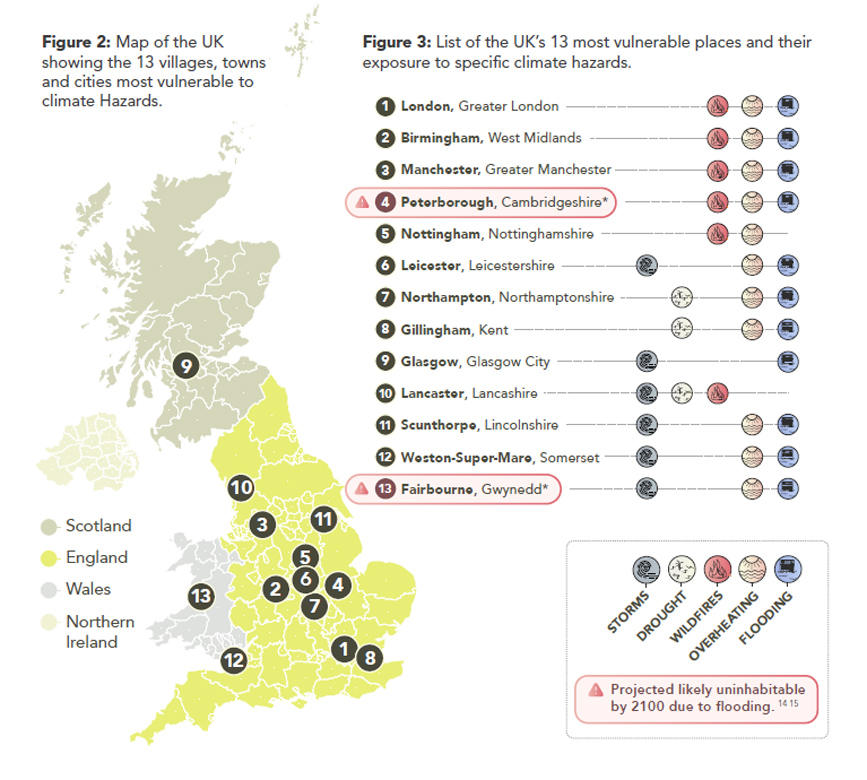
The UK’s most vulnerable places to overheating, flooding, and other climate risks are revealed in a major new report, the UK Climate Resilience Roadmap.
It warns that climate change means some schools can expect ‘heatwave’ like temperatures for 10 weeks a year, while flooding could make Peterborough uninhabitable this century.
The UK Climate Resilience Roadmap details, for the first time, how the UK’s built environment, including homes, schools, offices, hospitals parks and infrastructure, are increasingly vulnerable to five climate hazards — overheating, flooding, drought, wildfires and storms.
As parts of the UK face the prospect of a second heatwave in barely a week, modelling for the roadmap shows schools in London and the South East will likely face 10 weeks of extreme overheating risk in what is regarded as a ‘low future warming scenario’ of 2˚C — an independent scientific project that tracks government climate action, predicts we are on course for a 2.7˚C increase by the year 2100 (1).
The roadmap identifies 13 areas across the country most vulnerable to extreme weather hazards, with the cathedral city of Peterborough, and the Welsh village of Fairbourne, to become ‘likely uninhabitable’ by the turn of the century because of flooding. Places susceptible to storm, wildfires and drought are also highlighted.
Developed by the UK Green Building Council, and partners including Lloyds Banking Group, Mace, Arup, Zurich, Buro Happold and Hoare Lea and others (2) over two years, the roadmap also shows how buildings might be adapted to face a warmer and wetter future and calls on the government to treat climate resilience as a national emergency.
The report says:
- The 13 areas of the UK most vulnerable to storms, floods, overheating, wildfires and drought are in London, Birmingham, Manchester, Peterborough, Nottingham, Leicester, Northampton, Gillingham, Glasgow, Lancaster, Scunthorpe and Weston-Super-Mare (see header image).
- Six million homes (houses and flats) in London and the South East will face two weeks in excess of 28˚C a year in the low warming scenario, while healthcare buildings (doctors surgeries, healthcare centres and hospitals) are projected to face two weeks per year. Care homes in London and the South East will face temperatures in excess of 28˚C for four weeks per year.
- Flooding will make Peterborough and Fairbourne ‘likely uninhabitable’ by the end of the century.
As well as key messages for industry, the report contains policy recommendations for government, including calls to create an Office for Resilience in the Cabinet Office and restoring the role of Minister for Resilience, protecting all communities with trees, parks and ponds and creating a new generation of green professionals. The report sets out how built environment professionals can adopt a four-stage framework for embedding climate resilience into built environment decision-making across organisations and project teams.
Simon McWhirter, chief executive at the UK Green Building Council, said: “The UK Climate Resilience Roadmap starkly illustrates the threats of a changing climate, not in the future, but right here, right now. The UK is not ready for the extreme weather events of today, even less so for the hotter, wetter and wilder climate that is already racing down the track at us.
“Our homes, schools, hospitals, parks and offices are on the front line, protecting and nurturing us. They’re the essential ingredients that keep us warm, safe and comfortable, the very fabric of our communities and society, and they are in danger. We need a fundamental rethink on this if we are to help protect people and our way of life.
“While we need to keep doing everything we can to reduce the climate impacts ahead of us, in parallel we need to be preparing for a much hotter and more unpredictable world, now. With all the climate hazards that’ll bring, from more flash floods to rampant overheating in our buildings. It would be irresponsible of us not to do that. Policies and actions pledged to date by governments across the world mean we are projected to hit 2.75 of warming. So acting now is the only responsible choice; inaction wildly increases the risk, both morally and financially.
“Delaying action is costing lives and livelihoods. It is why we need climate resilience to be treated as a national emergency and why we are calling on the Government to create an Office for Resilience in the Cabinet Office, while restoring the role of Minister for Resilience. We are living through a changing climate, we must act now.”
You can download a copy of the Climate Resilience Roadmap here.
Notes:
1. The Climate Action Tracker, an independent scientific project that tracks government climate action and measures it against the globally agreed Paris Agreement aim of “holding warming well below 2°C, and pursuing efforts to limit warming to 1.5°C.”, predicts that, with current policies, we are on track for a 2.7°C increase by 2100. As the climate crisis worsens, the warming outlook stagnates | Climate Action Tracker
2. Programme partners were Hoare Lea; Hydrock now Stantec; JLL; Lloyds Banking Group. Roadmap Partners were Arup; Equans; Greengage; Mace; PRP; Ridge; Zurich Resilience Solutions. A steering group and task group were made up from wider industry.









